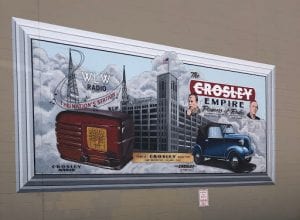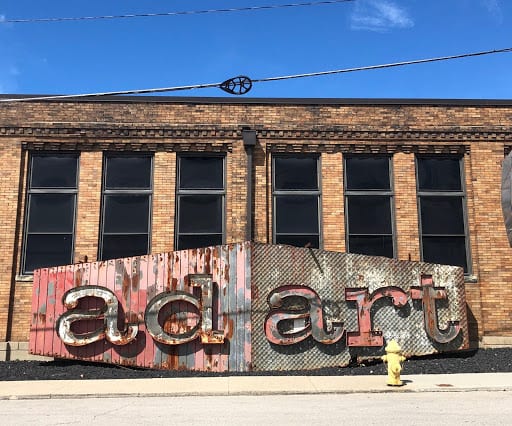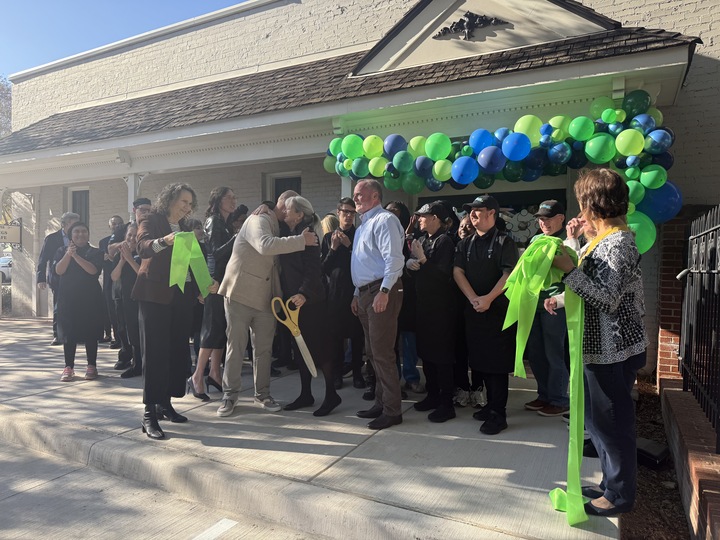Inside the American Sign Museum. (Photo by Michelle Eigenheer)
CINCINNATI — Tucked between warehouses and factories in Cincinnati’s Camp Washington neighborhood, the American Sign Museum maps the rise and decline of the city and region’s industry.
The museum’s collection of signs begins in the late 19th century, before electricity lit up the logos we recognize today. Its collection covers almost 100 years — through the lightbulb era, neon period and into the time of mass plastic production.
The museum was founded in 2005 by Tod Swormstedt, according to the museum’s website. Swormstedt was a fourth-generation editor for Signs of the Times, a trade magazine. He originally opened the museum as the Signs of the Times Museum, later relaunching the collection of signs and a library of decades of issues of the magazine as the American Sign Museum.
Hand-painted, gilded gold signs showcase craftsmanship and the popularity of cigar lounges and John Wayne movies. Movie posters and retail signs, the tour guide explains through an easy-to-use audio tour, varied city to city because what they advertised was open to interpretation by local artists. Later signs would use lightbulbs and punched metal to illuminate business logos; in the 1930s, neon entered the scene to illuminate city streets with a promise of dancing, food, drugs and Jesus. The museum’s central installation is Main Street, a model of what a shop-lined street could have looked like in the 1950s. Bubbling letters full of tinted water sit in the window of a paint shop, while a familiar illuminated arrow points to the drugstore. A vintage, larger-than-life McDonald’s sign stands in the middle of the cobblestone street.
The museum’s original name, Signs of the Times, is especially fitting when you consider that the tour path is an imprint of Cincinnati and the region’s industrial history. As you follow along with the audio segments, you can see painted barn-side signs for flour mills and tobacco companies give way to bright lights beckoning passing workers to manufacturing companies and steel mills. Around the 50s, manufacturing and steel drop off and new plastic signs advertising fast food and retail make their debut.

An advertisement for Crosley Radio features its now abandoned factory. (Photo by Michelle Eigenheer)
Perhaps the most poignant show of Cincinnati’s changing industry is the mural found along the wall parking lot in front of the museum’s main entrance. The Crosley Radio ad depicts one of the company’s famous radios and a Crosley car in front of the Crosley Empire’s huge factory and radio tower. Around the corner from this mural, the actual building sits vacant and condemned, a monument to urban decay. After the decline of analog audio, the company abandoned the production facility and moved downriver to Louisville, Ky., where their signage is a subtle logo on the side of a single-story building.
A $45 million plan to renovate the building into apartments fell through last year and the building went back on the market, reports Cincinnati.com. The 8-story structure is currently covered in decades worth of graffiti, signage for those who have climbed their way to the top.

A metal sign sits in front of the American Sign Museum. (Photo by Michelle Eigenheer)
As advertising moves off the main path and onto the Internet, once larger-than-life signs shrink. Giant Arby’s hats are broken to pieces, and old parts may even find their way to the museum’s in-house neon sign shop. A giant metal installation in front of the building features the words “ad art,” a memorial for what was once the most flashy way of getting customers in the door, now left in the dust.
As modern signage moves through minimalism and digital mediums, the gap between today’s signs and the museum’s collection continues to widen, making the journey all the more of a learning experience for guests.


